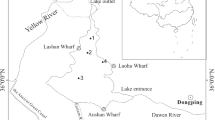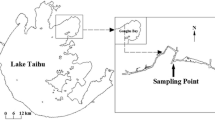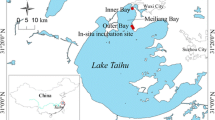Abstract
Ecological remediation is an important measure for the protection of lake water quality in removing nutrients, such as nitrate (NO3 −). In this study, four bioremediation processes (bare sediment, immobilized nitrogen cycling bacteria (INCB) added, Elodea nuttallii added, E. nuttallii-INCB assemblage) were operated at a lab to elucidate the effect of macrophyte appearance and INCB addition on NO3 − removal and achieve the optimal processes for biomediation. 15 N-NO3 solution was added to microcosms to identify the key nitrogen transformation processes responsible for NO3 − removal. Results showed that nitrate removal was significantly enhanced after the addition of INCB and E. nuttallii. In the treatments with INCB added, E. nuttallii added, and INCB and E. nuttallii-INCB assemblage, nitrate removal ratio achieved 94.74, 98.76, and 99.15 %, respectively. In contrast, only 23.47 % added nitrate was removed in the control. Plant uptake and denitrification played an important role in nitrogen removal. The water quality was substantially improved by the addition of INCB and macrophyte that can accelerate denitrification and promote nitrogen assimilation of plants. The results indicated that plant uptake and microbial denitrification were key processes for nitrate removal.





Similar content being viewed by others
References
Caffrey JM, Kemp WM (1992) Influence of the submersed plant, Potamogeton perfoliatus, on nitrogen cycling in estuarine sediments. Limnol Oceanogr 37:1483–1495
Cao GM, Zhao QX, Sun XB, Zhang T (2002) Characterization of nitrifying and denitrifying bacteria coimmobilized in PVA and kinetics model of biological nitrogen removal by coimmobilized cells. Enzym Microb Technol 30:49–55
Chen QC, Li ZK, Wang YC, Wu K, Fan NW (2012) Applied study of the submerged macrophytes bed-immobilized bacteria in drinking water restoration. Huanjing Kexue 33:83–87
Christensen PB, Sørensen J (1986) Temporal variation of denitrification activity in plant-covered, littoral sediment from Lake Hampen, Denmark. Appl Environ Microbiol 51:1174–1179
Epstein DM, Wurtsbaugh WA, Baker MA (2012) Nitrogen partitioning and transport through a subalpine lake measured with an isotope tracer. Limnol Oceanogr 57:1503–1516
Eriksson PG, Weisner SEB (1999) An experimental study on effects of submersed macrophytes on nitrification and denitrification in ammonium-rich aquatic systems. Limnol Oceanogr 44:1993–1999
Feast NA, Dennis PF (1996) A comparison of methods for nitrogen isotope analysis of groundwater. Chem Geol 129:167–171
Gift DM, Groffman PM, Kaushal SS, Mayer PM (2010) Denitrification potential, root biomass, and organic matter in degraded and restored urban riparian zones. Restor Ecol 18:113–120
Hamilton DP, Landman MJ (2011) Preface: Lake restoration: an experimental ecosystem approach for eutrophication control. Hydrobiologia 661:1–3
Herrmann M, Saunders AM, Schramm A (2009) Effect of lake trophic status and rooted macrophytes on community composition and abundance of ammonia-oxidizing prokaryotes in freshwater sediments. Appl Environ Microbiol 75:3127–3136
Joerdening HJ, Hausmann K, Demuth B, Zastrutzki M (2006) Use of immobilised bacteria for the wastewater treatment—examples from the sugar industry. Water Sci Technol 53:9–15
Jun B-H, Miyanaga K, Tanji Y, Unno H (2003) Removal of nitrogenous and carbonaceous substances by a porous carrier–membrane hybrid process for wastewater treatment. Biochem Eng J 14:37–44
Kreiling RM, Richardson WB, Cavanaugh JC, Bartsch LA (2011) Summer nitrate uptake and denitrification in an upper Mississippi River backwater lake: the role of rooted aquatic vegetation. Biogeochemistry 104:309–324
Lee C-G, Fletcher TD, Sun G (2009) Nitrogen removal in constructed wetland systems. Eng Life Sci 9:11–22
Matheson FE, Nguyen ML, Cooper AB, Burt TP, Bull DC (2002) Fate of N-15-nitrate in unplanted, planted and harvested riparian wetland soil microcosms. Ecol Eng 19:249–264
Penton CR, Deenik JL, Popp BN, Bruland GL, Engstrom P, Louis DS, Tiedje J (2013) Importance of sub-surface rhizosphere-mediated coupled nitrification-denitrification in a flooded agroecosystem in Hawaii. Soil Biol Biochem 57:362–373
Picek T, Kastovska E, Edwards K, Zemanova K, Dusek J (2008) Short term effects of experimental eutrophication on carbon and nitrogen cycling in two types of wet grassland. Community Ecol 9:81–90
Pina-Ochoa E, Alvarez-Cobelas M (2006) Denitrification in aquatic environments: a cross-system analysis. Biogeochemistry 81:111–130
Qiao M, Wang CX, Huang SB, Wang DH, Wang ZJ (2006) Composition, sources, and potential toxicological significance of PAHs in the surface sediments of the Meiliang Bay, Taihu Lake, China. Environ Int 32:28–33
Reddy KR, Patrick WH, Lindau CW (1989) Nitrification-denitrification at the plant root-sediment interface in wetlands. Limnol Oceanogr 34:1004–1013
Reinhardt M, Müller B, Gächter R, Wehrli B (2006) Nitrogen removal in a small constructed wetland: an isotope mass balance approach. Environ Sci Technol 40:3313–3319
Scheffer M, Szabo S, Gragnani A, van Nes EH, Rinaldi S, Kautsky N, Norberg J, Roijackers RMM, Franken RJM (2003) Floating plant dominance as a stable state. Proc Natl Acad Sci U S A 100:4040–4045
Schubert CJ, Durisch-Kaiser E, Wehrli B, Thamdrup B, Lam P, Kuypers MMM (2006) Anaerobic ammonium oxidation in a tropical freshwater system (Lake Tanganyika). Environ Microbiol 8:1857–1863
Seitzinger S, Harrison JA, Bohlke JK, Bouwman AF, Lowrance R, Peterson B, Tobias C, Van Drecht G (2006) Denitrification across landscapes and waterscapes: a synthesis. Ecol Appl 16:2064–2090
Smith VH, Tilman GD, Nekola JC (1999) Eutrophication: impacts of excess nutrient inputs on freshwater, marine, and terrestrial ecosystems. Environ Pollut 100:179–196
Soana E, Bartoli M (2014) Seasonal regulation of nitrification in a rooted macrophyte (Vallisneria spiralis L.) meadow under eutrophic conditions. Aquat Ecol 48:11–21
Sollie S, Verhoeven JTA (2008) Nutrient cycling and retention along a littoral gradient in a Dutch shallow lake in relation to water level regime. Water Air Soil Pollut 193:107–121
Song C, Wang Y, Wang Y, Zhao Z (2006) Emission of CO2, CH4 and N2O from freshwater marsh during freeze–thaw period in Northeast of China. Atmos Environ 40:6879–6885
Søvik AK, Mørkved PT (2008) Use of stable nitrogen isotope fractionation to estimate denitrification in small constructed wetlands treating agricultural runoff. Sci Total Environ 392:157–165
Toet S, Huibers L, Van Logtestijn RSP, Verhoeven JTA (2003) Denitrification in the periphyton associated with plant shoots and in the sediment of a wetland system supplied with sewage treatment plant effluent. Hydrobiologia 501:29–44
Ullah S, Zhang H, Heathwaite AL, Heppell C, Lansdown K, Binley A, Trimmer M (2014) Influence of emergent vegetation on nitrate cycling in sediments of a groundwater-fed river. Biogeochemistry 118:121–134
Wang Y, Li Z, Zhou L, Feng L, Fan N, Shen J (2013) Effects of macrophyte-associated nitrogen cycling bacteria on denitrification in the sediments of the eutrophic Gonghu Bay, Taihu Lake. Hydrobiologia 700:329–341
Zeng J, Yang L, Li J, Liang Y, Xiao L, Jiang L, Zhao D (2009) Vertical distribution of bacterial community structure in the sediments of two eutrophic lakes revealed by denaturing gradient gel electrophoresis (DGGE) and multivariate analysis techniques. World J Microbiol Biotechnol 25:225–233
Zeng J, Bian Y, Xing P, Wu QL (2012) Macrophyte species drive the variation of bacterioplankton community composition in a shallow freshwater lake. Appl Environ Microbiol 78:177–184
Zhang LS, Wu WZ, Wang JL (2007) Immobilization of activated sludge using improved polyvinyl alcohol (PVA) gel. J Environ Sci 19:1293–1297
Zhang J, Zhu T, Cai Z, Qin S, Müller C (2012) Effects of long-term repeated mineral and organic fertilizer applications on soil nitrogen transformations. Eur J Soil Sci 63:75–85
Zhao L, Li ZK, Zhou T, Wu NM, Ye ZX, Liu DD (2013) Denitrification study of Elodea nuttallii-nitrogen cycling bacteria restoration in Meiliang Bay, Taihu Lake. Huanjing Kexue 34:3057–3063
Acknowledgments
This study was financially supported by research projects of the Major State Water Pollution Control and Treatment Technique Programs of China (Nos. 2012ZX07101006, 2013ZX07101014-001). We sincerely thank Dr. Zhang Lu and Dr. Zhang Jinbo for providing valuable advice on isotope sample tests. We thank Dr. Wang Jianjun for his technical assistance in using the O2 microprobe equipment.
Author information
Authors and Affiliations
Corresponding author
Additional information
Responsible editor: Hailong Wang
Rights and permissions
About this article
Cite this article
Liu, D., Li, Z. & Zhang, W. Nitrate removal under different ecological remediation measures in Taihu Lake: a 15 N mass-balance approach. Environ Sci Pollut Res 21, 14138–14145 (2014). https://doi.org/10.1007/s11356-014-3328-3
Received:
Accepted:
Published:
Issue Date:
DOI: https://doi.org/10.1007/s11356-014-3328-3




